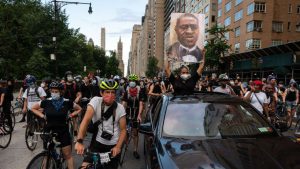JUNE 27, 2020

Protesters marched through Columbus Circle in Manhattan on Juneteenth. – Diana Zeyneb Alhindawi/NY Times
A majority of American voters support the demonstrations against police brutality and racial injustice that have roiled the country over the past month, embracing ideas about bias within the criminal justice system and the persistence of systemic racism that are central tenets of the Black Lives Matter movement, according to a new national poll of registered voters by The New York Times and Siena College.
Fifty-nine percent of voters, including 52 percent of white voters, believe the death of George Floyd at the hands of the police in Minneapolis was “part of a broader pattern of excessive police violence toward African Americans,” the poll found. The Black Lives Matter movement and the police had similar favorability ratings, with 44 percent of registered voters viewing the movement as “very favorable,” almost identical to the 43 percent rating for the police.
The numbers add to the mounting evidence that recent protests have significantly shifted public opinion on race, creating potential political allies for a movement that was, within the past decade, dismissed as fringe and divisive. It also highlights how President Trump is increasingly out of touch with a country he is seeking to lead for a second term: While he has shown little sympathy for the protesters and their fight for racial justice, and has continued to use racist language that many have denounced, voters feel favorably toward the protests and their cause.
A survey of battleground states critical to November’s election largely mirrored the national results. Fifty-four percent of voters in those states said the way the criminal justice system treats black Americans was a bigger problem than the incidents of rioting seen during some demonstrations. Just 37 percent said rioting was a bigger problem, though Mr. Trump and his allies have tried to discredit the protests by focusing on some isolated incidents of violence.
It has not worked.
“I probably didn’t understand what bringing people together meant until Trump started talking the way he does,” said Rita Hopkins, 55, from rural Clark County, Mo., in the northeastern part of the state. “Now I see what a president says can divide people.”
Ms. Hopkins, a white registered Democrat who describes herself as a centrist, said she was particularly galled by Mr. Trump’s comments at one point during protests over Mr. Floyd’s death that the Secret Service had been prepared to sic the “most vicious dogs” on protesters outside the White House gates.
The words immediately brought to mind photos of the Alabama police aiming snarling dogs at peaceful black protesters.
“I hate to say it, but I had forgotten about those pictures I had seen,” said Ms. Hopkins, who lives in an overwhelmingly Republican county. “I kind of thought we had gotten past that.”
The attitudes cut across race, geography and educational status, and speak to a country that has been awakened through protests to complaints that black Americans have long made about police brutality and systemic racism. What began in the Democratic primary, in which white liberals showed a new openness to candidates speaking frankly about systemic injustice, has continued into the general election, with a spotlight on Mr. Trump’s response.
The coalition of people sympathetic to the protesters’ cause, including Latino voters, exposes the limits of Mr. Trump’s tendency to exclusively speak directly to his overwhelmingly white and conservative base. As with other issues, including the coronavirus pandemic, the administration’s narrow focus has been derided by experts and voters, who say the governing strategy does not reflect the country’s broader interests, or the current political realities.
“Over the past six years, so much of the work has been focused on convincing the country — and convincing policymakers and white communities that there’s an actual problem,” said Samuel Sinyangwe, an activist and co-founder of Mapping Police Violence. “Now there’s been universal condemnation of the George Floyd incident and a recognition that things needs to change.”
Aaron Perry, an alderman on the City Council of Waukesha, Wis., said he doesn’t support the looting that took place after Mr. Floyd’s death in various cities but said it occurred on a small scale relative to the peaceful protests that broke out.
Mr. Perry, a 40-year-old white man, describes himself as a centrist but was compelled to switch parties last year from Republican to Democrat because of his support for marriage equality and legalization of cannabis. He called himself a “never-Trumper” and said that in 2016, he wrote in John Kasich, then the governor of Ohio, on the presidential ballot.
The death of Mr. Floyd was an urgent message to the nation, he said, to make changes to end the kinds of police and societal behavior that led to the incident.
“This is the last time we have a chance to get this right. I’m on board with that,” Mr. Perry said, emphasizing, with an expletive, that he really didn’t care if “most of the people I represent don’t look like” Mr. Floyd, and that issues of racial justice matter for a majority-white area, too.
Darrell Keaton Sr., a 49-year-old black Democrat from Wausau, Wis., several hours north of Mr. Perry, said the protests after Mr. Floyd’s death were monumental for chancing views on structural racism in America. Finally, he said, it feels like white people are listening and joining in the protests.
“We have just been racking our brains and screaming at the top of our lungs for so many years that we’re going to need other people to stand up alongside the black community to change anything,” he said.
Though the poll over all shows former Vice President Joseph R. Biden Jr. in a very strong position, especially on racial justice, and voters’ belief in his ability to unite a divided country, it also indicates how difficult a task that could be: More than 40 percent of white respondents agreed in some measure that discrimination against whites has become as big a problem as other forms of discrimination, reinforcing a theme of white grievance politics that the president and his supporters have long expressed.
There are also broad generational gaps between how voters are responding to the national moment of unrest. Every age bracket said the use of force by the police against black Americans was a bigger problem than looting at demonstrations, however support for Black Lives Matter gets more tepid among older voters, the polls found. Sixty-seven percent of voters ages 18 to 29 viewed the Black Lives Matter movement as “very favorable” as did 54 percent of voters ages 30 to 44.

The new poll highlights how President Trump is increasingly out of touch with a country he is seeking to lead for a second term. – Erin Schaff/NY Times
Among people 45 to 64, the support dropped to 37 percent, while 22 percent viewed the movement as “somewhat favorable.” Voters 65 and over were the least persuaded: Only 31 percent had a “very favorable” view of the Black Lives Matter movement, and 25 percent had a “somewhat favorable” opinion.
Michael Berlinger, 67, who lives in Lancaster, Pa., and considers himself an independent voter, said he thinks the Black Lives Matter movement is too myopic. The protests over Mr. Floyd’s death have been too destructive, he said.
“The whole message has been undermined in a lot of ways,” said Mr. Berlinger, a white retired teacher. “I’m not a big fan of people who break the law to say they’re working for a cause. I don’t think that’s the correct way of doing it.”
The looting and the property destruction were “a dilution of the message and the results they wanted to achieve.” Mr. Berlinger is likely to vote for Mr. Trump, he said, but he described the choices on the Republican and Democratic ballots, respectively, as one between “a lunatic and a senile senior citizen.”
“I think all lives matter,” Mr. Berlinger said. “The black and blue lives, and red, white and blue lives.”
Charles Defever, a 28-year-old Minneapolis Democrat, said he felt this was a moment to get more involved. His activism was limited to the occasional comment in support of Black Lives Matter on social media — until he saw the video of George Floyd’s arrest, he said.
“I was not very active, and my interest would fade,” said Mr. Defever, who is white and works as a produce buyer for a food wholesaler. “I would write on the Black Lives Matter page and see truth and pain and hurt in so many people I know but would not go out and protest.”
“I’ve spent a lot of time at the State Capitol listening to young black and brown youth speak about the world they want, and that’s the world I have,” he said.
Mr. Defever was a supporter of Senator Bernie Sanders of Vermont but said he planned to vote for Mr. Biden because he was “better than having destructive Republican policies and leadership.”
Many activists, progressive political groups, and civil rights organizations draw a direct line to these changing attitudes and the events of the recent months. Renewed attention ignited by the death of Mr. Floyd — as well as others who died at the hands of police, including Breonna Taylor of Kentucky, Rayshard Brooks of Georgia, and Elijah McClain of Colorado — has built on other moments of awakening, like the surprise of the 2016 election of Mr. Trump, said Nell Irvin Painter, a historian and the author of “The History of White People.”
“The great stall point after the civil rights movement was white people not being able to talk to other white people about whiteness,” Ms. Painter said. “That has to happen before anything can change. Now, many white people are stepping up and saying, ‘Oh we’ve got to talk about this.’”
D’Atra Jackson, national director for Black Youth Project 100, the progressive political organization that has been on the front lines of the national protests, agreed that this is a unique political moment. However, Ms. Jackson said it is important to maintain pressure on people seeking elected office so that public sympathy can be transformed into action — getting people elected and getting legislation passed.
“It’s one thing to be hopeful and believe that new things are possible,” Ms. Jackson said. “It’s another thing to build power.”
Courtesy/Source: NY Times










































































































